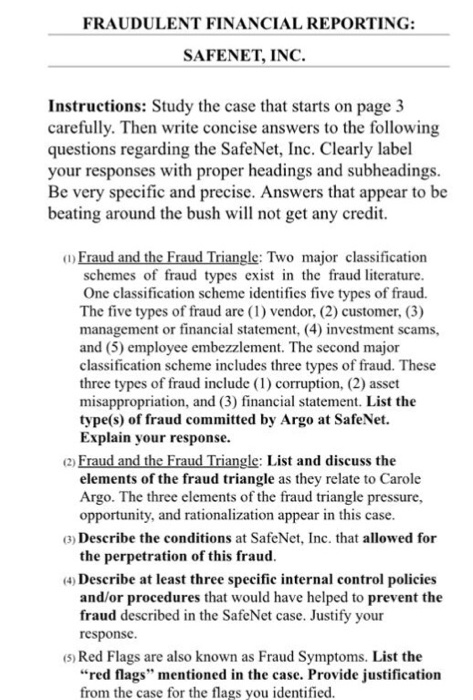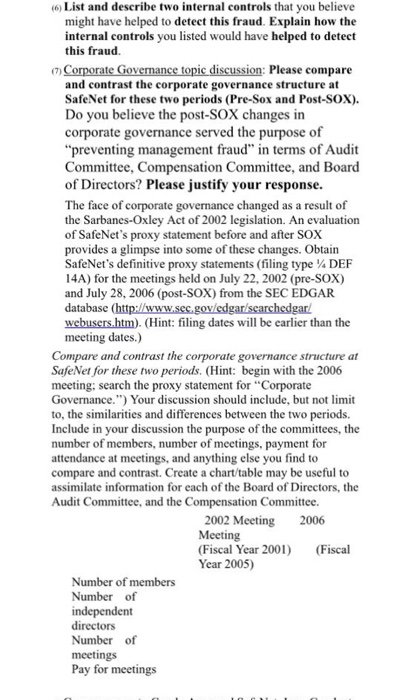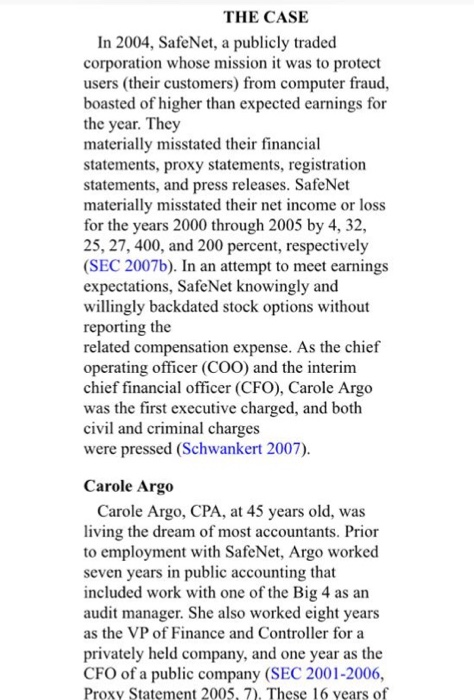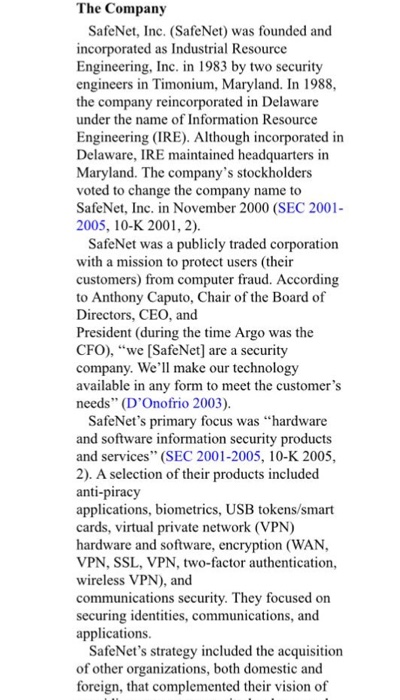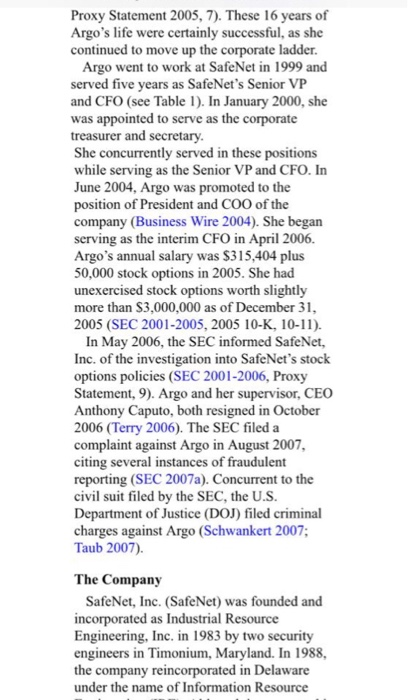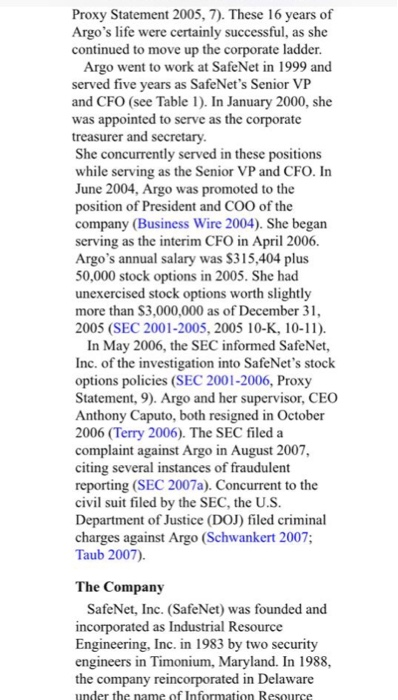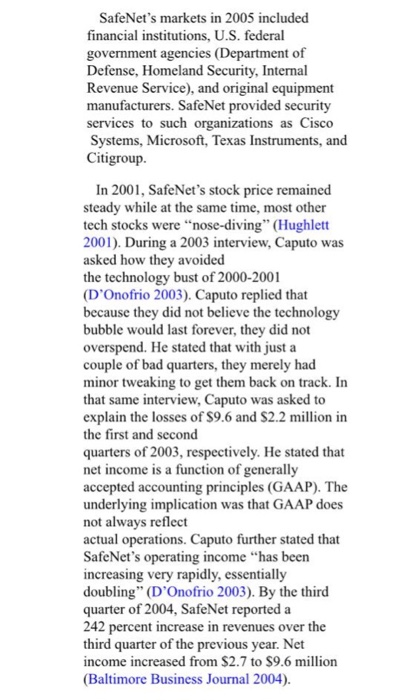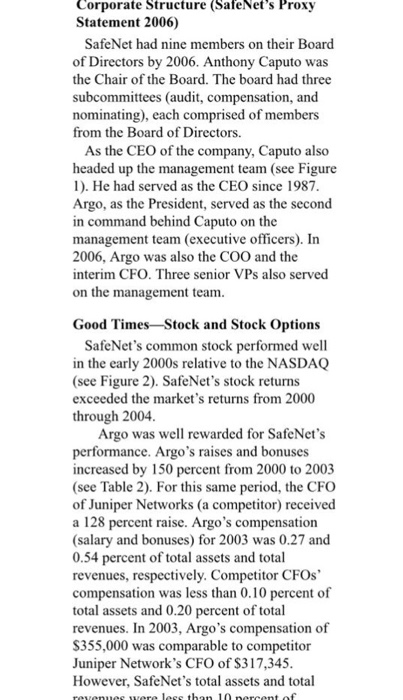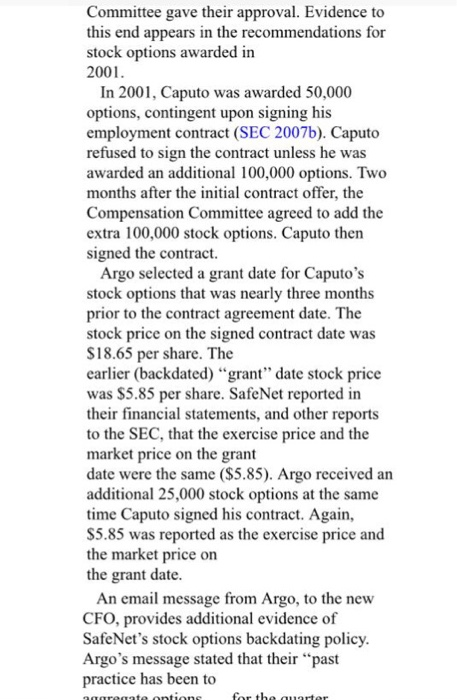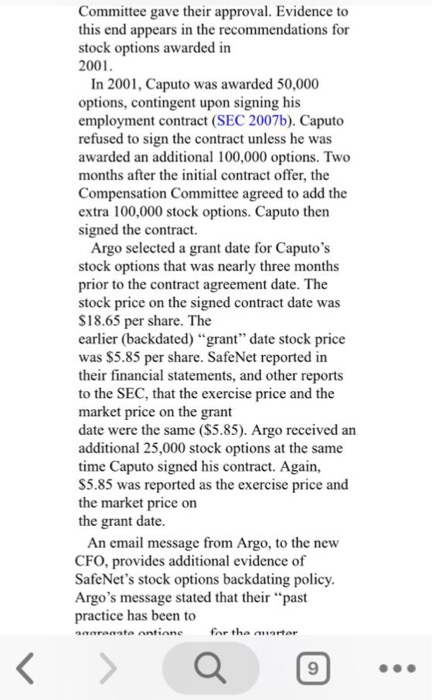FRAUDULENT FINANCIAL REPORTING: SAFENET, INC. Instructions: Study the case that starts on page 3 carefully. Then write concise answers to the following questions regarding the SafeNet, Inc. Clearly label your responses with proper headings and subheadings. Be very specific and precise. Answers that appear to be beating around the bush will not get any credit Two major classification schemes of fraud types exist in the fraud literature One classification scheme identifics five types of fraud. The five types of fraud are(1) vendor, (2) customer, (3) management or financial statement, (4) investment scams, and (5) employee embezzlement. The second major classification scheme includes three types of fraud. These three types of fraud include (1) corruption, (2) asset misappropriation, and (3) financial statement. List the type(s) of fraud committed by Argo at SafeNet. Explain your response. 2) Fraud and the Fraud Triangle: List and discuss the elements of the fraud triangle as they relate to Carole Argo. The three elements of the fraud triangle pressure, opportunity, and rationalization appear in this case 3) Describe the conditions at SafeNet, Inc. that allowed for the perpetration of this fraud 4) Describe at least three specific internal control policies and/or procedures that would have helped to prevent the fraud described in the SafeNet case. Justify your respons s) Red Flags are also known as Fraud Symptoms. List the "red flags" mentioned in the case. Provide justification from the case for the flags you identified. s Consequences to Carole Argo and SafeNet, Inc.: Conduct research to determine the outcomes of the SEC v. Carole Argo and the U.S. DOJ v. Carole Argo. Describe the outcomes and the consequences imposed on Carole Argo. Document your sources Note: Be specific in supporting your points. For example, simply stating that the company's segregation of duties appear satisfactory as a strength will receive no credit. You must clearly articulate which duty is segregated from what other duties and how this segregation helps to strengthen the company's internal control. Page limit is 8, standard margin, Times New Roman 12 font. SafeNet: A Case of Fraudulent Financial Reporting Carol Argo participated in the awarding of stock options at SafeNet and found herself in trouble On one hand, it would appear that Carole Argo was simply following company policy with respect to the granting of stock options. It might appear that she was simply maintaining the procedures of her superior, Anthony Caputo, Chair of the Board and CEO, by selecting previous dates as the stock options grant dates. This procedure, in and of itself, does not violate any of the applicable accounting standards (see Appendix A for a basic description of stock options and backdating). So what is the problem? Why did she resign? Why did she not stay with the company and fight her case? Why did the SEC and the U.S. Department of Justice (DOJ) press charges? Where did she go wrong? Was she being unjustly targeted? THE CASE In 2004, SafeNet, a publicly traded corporation whose mission it was to protect users (their customers) from computer fraud, THE CASE In 2004, SafeNet, a publicly traded corporation whose mission it was to protect users (their customers) from computer fraud, boasted of higher than expected earnings for the year. They materially misstated their financial statements, proxy statements, registration statements, and press releases. SafeNet materially misstated their net income or loss for the years 2000 through 2005 by 4, 32, 25, 27, 400, and 200 percent, respectively (SEC 2007b). In an attempt to meet earnings expectations, SafeNet knowingly and willingly backdated stock options without reporting the related compensation expense. As the chief operating officer (COO) and the interim chief financial officer (CFO), Carole Argo was the first executive charged, and both civil and criminal charges were pressed (Schwankert 2007) Carole Argo Carole Argo, CPA, at 45 years old, was living the dream of most accountants. Prior to employment with SafeNet, Argo worked seven years in public accounting that included work with one of the Big 4 as an audit manager. She also worked eight years as the VP of Finance and Controller for a privately held company, and one year as the CFO of a public company (SEC 2001-2006, Proxy Statement 2005, 7). These 16 vears of Proxy Statement 2005, 7). These 16 years of Argo's life were certainly successful, as she continued to move up the corporate ladder. Argo went to work at SafeNet in 1999 and served five and CFO (see Table ). In January 2000, she was appointed to serve as the corporate treasurer and secretary She concurrently served in these positions while serving as the Senior VP and CFO. In June 2004, Argo was promoted to the position of President and COO of the company (Business Wire 2004). She began serving as the interim CFO in April 2006. Argo's annual salary was S315,404 plus 50,000 stock options in 2005. She had unexercised stock options worth slightly more than S3,000,000 as of December 31, 2005 (SEC 2001-2005, 2005 10-K, 10-11). years as SafeNet's Senior VP In May 2006, the SEC informed SafeNet, Inc. of the investigation into SafeNet's stoclk options policies (SEC 2001-2006, Proxy Statement, 9). Argo and her supervisor, CEO Anthony Caputo, both resigned in October 2006 (Terry 2006). The SEC filed a complaint against Argo in August 2007, citing several instances of fraudulent reporting (SEC 2007a). Concurrent to the civil suit filed by the SEC, the U.S. Department of Justice (DOJ) filed criminal charges against Argo (Schwankert 2007; Taub 2007). The Company SafeNet, Inc. (SafeNet) was founded and incorporated as Industrial Resource Engineering, Inc. in 1983 by two security engineers in Timonium, Maryland. In 1988, the company reincorporated in Delaware under the name of Information Resource Proxy Statement 2005, 7). These 16 years of Argo's life were certainly successful, as she continued to move up the corporate ladder Argo went to work at SafeNet in 1999 and served five and CFO (see Table 1). In January 2000, she was appointed to serve as the corporate treasurer and secretary She concurrently served in these positions while serving as the Senior VP and CFO. In June 2004, Argo was promoted to the position of President and COO of the company (Business Wire 2004). She began serving as the interim CFO in April 2006. Argo's annual salary was S315,404 plus 50,000 stock options in 2005. She had unexercised stock options worth slightly more than S3,000,000 as of December 31, 2005 (SEC 2001-2005, 2005 10-K, 10-11). years as SafeNet's Senior VIP In May 2006, the SEC informed SafeNet, Inc. of the investigation into SafeNet's stock options policies (SEC 2001-2006, Proxy Statement, 9). Argo and her supervisor, CEO Anthony Caputo, both resigned in October 2006 (Terry 2006). The SEC filed a complaint against Argo in August 2007, citing several instances of fraudulent reporting (SEC 2007a). Concurrent to the civil suit filed by the SEC, the U.S. Department of Justice (DOJ) filed criminal charges against Argo (Schwankert 2007; Taub 2007). The Company SafeNet, Inc. (SafeNet) was founded and incorporated as Industrial Resource Engineering, Inc. in 1983 by two security engineers in Timonium, Maryland. In 1988, the company reincorporated in Delaware SafeNet's markets in 2005 included financial institutions, U.S. federal government agencies (Department of Defense, Homeland Security, Internal Revenue Service), and original equipment manufacturers. SafeNet provided security services to such organizations as Cisco Systems, Microsoft, Texas Instruments, and Citigroup In 2001, SafeNet's stock price remained steady while at the same time, most other tech stocks were "nose-diving" (Hughlett 2001). During a 2003 interview, Caputo was asked how they avoided the technology bust of 2000-2001 (D'Onofrio 2003). Caputo replied that because they did not believe the technology bubble would last forever, they did not overspend. He stated that with just a couple of bad quarters, they merely had minor tweaking to get them back on track. In that same interview, Caputo was asked to explain the losses of S9.6 and S2.2 million in the first and second quarters of 2003, respectively. He stated that net income is a function of generally accepted accounting principles (GAAP). The underlying implication was that GAAP does not always reflect actual operations. Caputo further stated that SafeNet's operating income "has been increasing very rapidly, essentially doubling" (D'Onofrio 2003). By the third quarter of 2004, SafeNet reported a 242 percent increase in revenues over the third quarter of the previous year. Net income increased from $2.7 to $9.6 million (Baltimore Business Journal 2004). Corporate Structure (SafeNet's Proxy Statement 2006) SafeNet had nine members on their Board of Directors by 2006. Anthony Caputo was the Chair of the Board. The board had three subcommittees (audit, compensation, and nominating), each comprised of members from the Board of Directors. As the CEO of the company, Caputo also headed up the management team (see Figure 1). He had served as the CEO since 1987. Argo, as the President, served as the second in command behind Caputo on the management team (executive officers). In 2006, Argo was also the COO and the interim CFO. Three senior VPs also served on the management team Good Times-Stock and Stock Options SafeNet's common stock performed well in the early 2000s relative to the NASDAQ (see Figure 2). SafeNet's stock returns exceeded the market's returns from 2000 through 2004 Argo was well rewarded for SafeNet's performance. Argo's raises and bonuses increased by (see Table 2). For this same period, the CFO of Juniper Networks (a competitor) received a 128 percent raise. Argo's compensation (salary and bonuses) for 2003 was 0.27 and 0.54 percent of total assets and total revenues, respectively. Competitor CFOs compensation was less than 0.10 percent of total assets and 0.20 percent of total revenues. In 2003, Argo's compensation of S355,000 was comparable to competitor Juniper Network's CFO of S317,345 However, SafeNet's total assets and total 150 percent from 2000 to 2003 Committee gave their approval. Evidence to this end appears in the recommendations for stock options awarded in 2001 In 2001, Caputo was awarded 50,000 options, contingent upon signing his employment contract (SEC 2007b). Caputo refused to sign the contract unless he was awarded an additiona 100,000 options. Two months after the initial contract offer, the Compensation Committee agreed to add the extra 100,000 stock options. Caputo then signed the contract. Argo selected a grant date for Caputo's stock options that was nearly three months prior to the contract agreement date. The stock price on the signed contract date was S18.65 per share. The earlier (backdated) "grant" date stock price was $5.85 per share. SafeNet reported in their financial statements, and other reports to the SEC, that the exercise price and the market price on the grant date were the same ($5.85). Argo received an additional 25,000 stock options at the same time Caputo signed his contract. Again, S5.85 was reported as the exercise price and the market price on the grant date An email message from Argo, to the new CFO, provides additional evidence of SafeNet's stock options backdating policy Argo's message stated that their "past practice has been to Committee gave their approval. Evidence to this end appears in the recommendations for stock options awarded in 2001 In 2001, Caputo was awarded 50,000 options, contingent upon signing his employment contract (SEC 2007b). Caputo refused to sign the contract unless he was awarded an additional 100,000 options. Two months after the initial contract offer, the Compensation Committee agreed to add the extra 100,000 stock options. Caputo then signed the contract. Argo selected a grant date for Caputo's stock options that was nearly three months prior to the contract agreement date. The stock price on the signed contract date was S18.65 per share. The earlier (backdated) "grant" date stock price was $5.85 per share. SafeNet reported in their financial statements, and other reports to the SEC, that the exercise price and the market price on the grant date were the same (S5.85). Argo received an additional 25,000 stock options at the same time Caputo signed his contract. Again, S5.85 was reported as the exercise price and the market price on the grant date An email message from Argo, to the new CFO, provides additional evidence of SafeNet's stock options backdating policy Argo's message stated that their "past practice has been to ontinnefar tha
